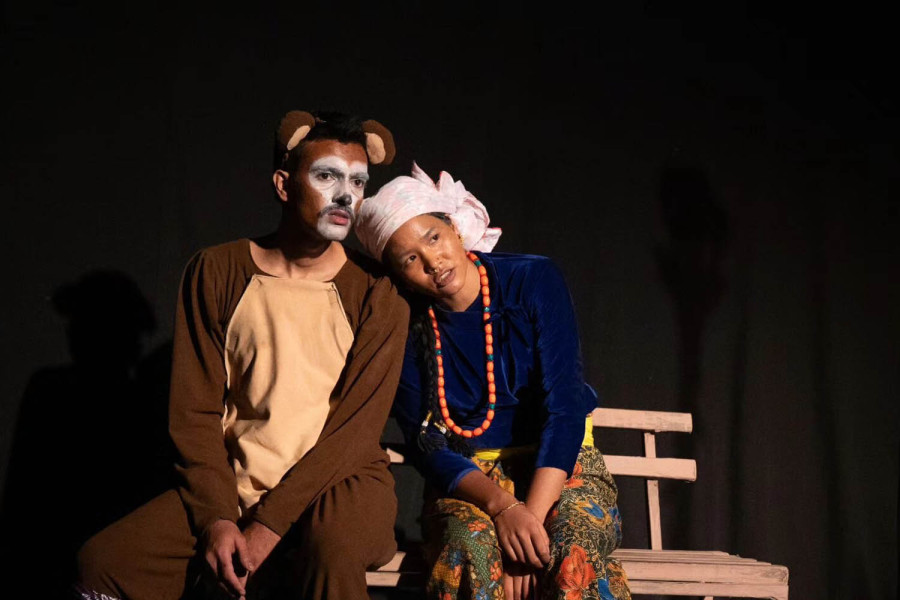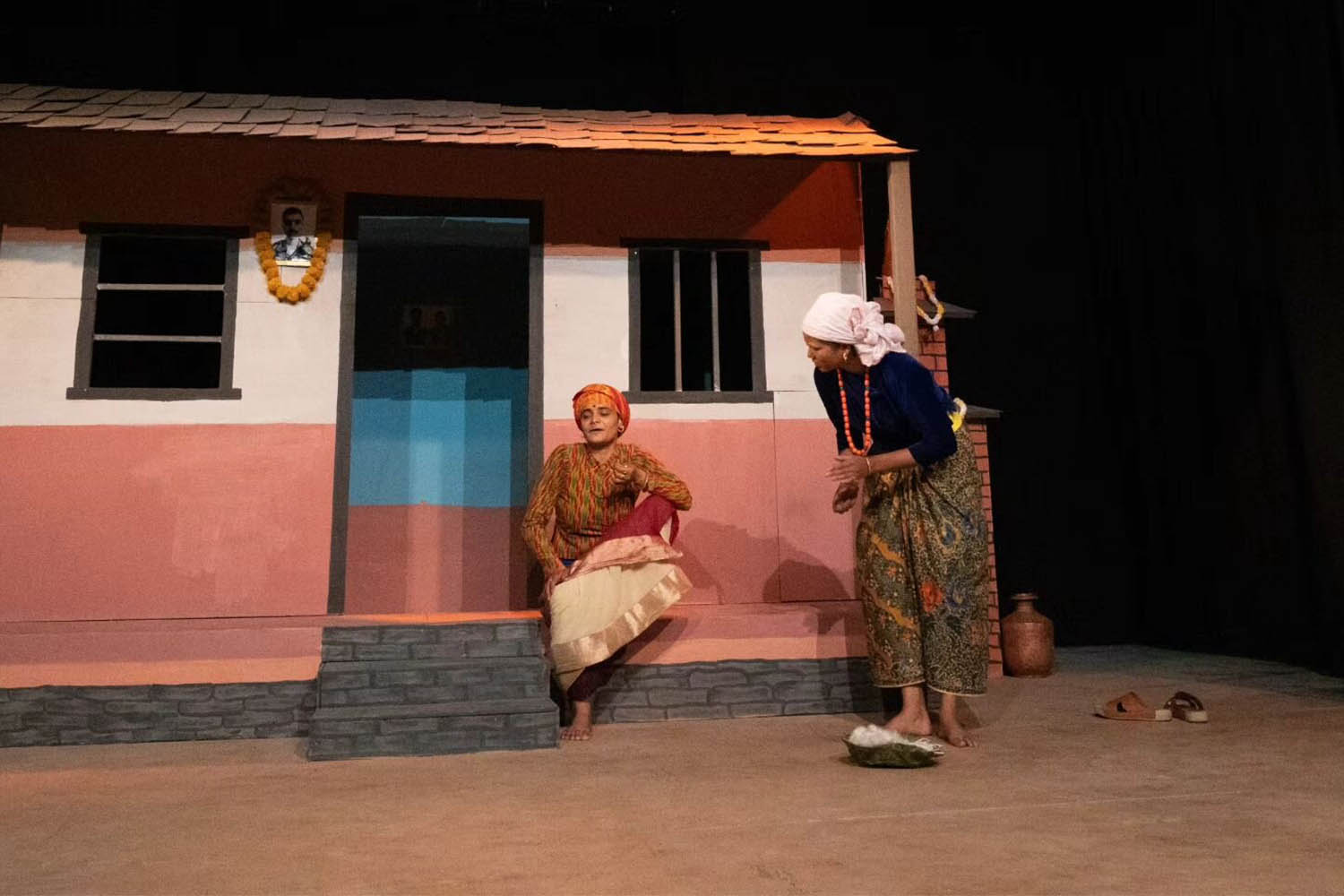Theater
Family fragility and migration
‘Kaacho Dhaago’ tells the story of familial separation set against a village grappling with drought and monkey raids.
Rishika Dhakal
‘Kaacho Dhaago’ unfolds against seasonal drought, the vibrant melodies of the Magar community, Gandharva dance, crop-raiding monkeys, and an old woman's yearning to reconnect with her family.
Written by Mukti and directed by Aashant Sharma, the play centres on an urban village in the Gandaki Province, highlighting the dynamics of a family bound by blood but separated by distance.
The title ‘Kaacho Dhaago’ symbolises the fragility of relationships, with ‘Kaacho’ representing their fickleness. Traditionally used for sewing, the ‘Dhago’ (thread) is a metaphor for its inability to weave strong connections between family members.
Laureni Aama (Ayushma Magar) is an old widow. She engages in casual banter with Bastare Aamai (played by Nistha Tripathi) and Thula (Sagar Dahal). Thula, along with the other villagers of Gauradi Gaupalika, is desperately searching for ways to drive the monkeys out of the village. The entire community is at their wit’s end as the monkeys devour the annual harvest and invade homes, causing widespread destruction.
While the monkeys wreak havoc on the village, the play shifts to depict the life of Laureni Aama's younger son in America.
Nishan Khatri plays a charming Nepali-American bachelor, Ishwar. Having just completed his IT studies, Ishwar is offered a research opportunity in Nepal. However, his father, embodying the typical Nepali patriarch, insists that Ishwar remain in America to start an IT company jointly.
A heated argument breaks out between Ishwar and his father as Ishwar expresses his desire to return to Nepal. After tensions settle, the father reluctantly agrees to let Ishwar go on one condition: he must convince his grandmother to return to the US.
Things have taken a new turn in Nepal as Laureni Aamai befriends a monkey (played by Mukti), a regular visitor to their house, to steal the harvest. The relationship between the monkey and Laureni Aamai highlights the special and pure bond that can exist between humans and animals.
While Thula combs the village for monkeys, Laureni Aamai secretly starts caring for the monkey. She gives the monkey food to eat and applies bandages to the wound.
At this point in the play, metempsychosis is introduced, and Laureni Aamai begins to see the monkey as the reincarnation of her late husband. She shares her sorrow and sadness with the animal. The monkey listens intently as Laureni Aamai expresses her longing to reunite with her grandson Ishwar and her two sons in Kathmandu and America.
Laureni Aamai’s belief in superstition highlights the struggles of those whose families have gone abroad to seek wealth. In the play, superstition serves as a metaphor for the old memories that those left behind hold onto, helping them relive and cherish moments with loved ones who have departed. Despite the changing world, superstition symbolises their comfort in clinging to the past.
The friendship between the monkey and Laureni Aama depicts the sad picture of loneliness that the families experience as their children go abroad in search of work.
The mass exodus of Nepali youth to foreign countries is a recurring theme in plays and stories. Amidst the country’s turbulent politics, the play touches on Nepal's current political situation, emphasising the issue of brain drain.
The director may have had a different intention in portraying the monkey, but I couldn’t help but see it as a symbol of the nation’s many issues, like brain drain and family breakdown.
The proliferation of monkeys symbolises the saddening situation of our country’s politics, where roads are black-pitched just before the commencement of elections, and the words of the election manifesto are empty rhetoric.
Laureni Aamai's frustration is evident in her remark during the play: “Chaar haat tekera vote haalna gako, tei pani kei hudaina,” which loosely translates to, “After spending four hands’ worth of effort to cast my vote, nothing has changed.”
Frustrated by the government’s incompetence in controlling the monkeys, the daughter-in-law, Sabita (Mira Khadka), becomes a frequent visitor to the ward office. The ward office finally gives every household a gun to cast away the monkeys.
Thula, who isn’t the best listener, takes charge of the gun. As the play's comic relief, he constantly reminds Laureni Aamai to call him if she spots any monkeys nearby.

Despite Laureni Aamai already hearing him, Thula keeps repeating himself, convinced she hasn’t listened. This scene is a strong analogy, reflecting how society often treats older people like children, assuming they need constant explanations and guidance.
One can see the writing on the wall when Thula gets the gun. The audience's anxiety about the fate of the monkey gets heightened. Right on time, Laureni Aamai faints and, as a result, falls sick.
On the other hand, Ishwar is planning to surprise Laureni Aamai with his visit to Nepal. The scene is then followed by a tragic irony where Ishwar’s arrival coincides with Laureni Aamai witnessing the death of her beloved monkey. Consumed by an overwhelming sorrow, Laureni Aamai breathes her last.
The play's tragic conclusion, with the deaths of the main characters, mirrors a common pattern in Nepali films, where death is used to elicit strong emotional responses from the audience.
The ending appears to be hastily constructed to expedite the conclusion of the play.
Stock characters and repetitive scenes in the play do little to advance the storyline. For example, the gainey who comes to sing at Laureni Aamai’s home doesn’t contribute meaningfully to the plot and instead seems to exaggerate it. This makes the audience wonder if the creators envisioned their intended message.
On the positive side, the play offers a nuanced portrayal of the relationship between daughter-in-law and mother-in-law. Unlike many dramas, films, and plays that often depict these relationships in a negative light under the pretence of realism, this play shows a more complex and respectful dynamic.
The highlight of the theatre was the use of songs as a form of musical catharsis, effectively conveying the emotions the actors aimed to express.
Although the storyline may not have succeeded, the actors’ strong, character-driven performances elevated the play to a new level.
Kaacho Dhago
Director: Aashant Sharma
Cast: Ayushma Magar, Mira Khadka, Nishan Khatri Chhetri, Mukti
Venue: Kausi Theatre, Teku, Kathmandu
Showtimes: Every day at 5:15 pm and an extra 1:00 pm show on Saturday until September 14




 18.35°C Kathmandu
18.35°C Kathmandu











